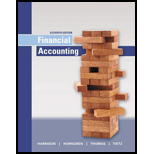
a.
Bonds Payable: Bonds payable are referred to long-term debts of the business, issued to various lenders known as bondholders, generally in multiples of $1,000 per bond, to raise fund for financing the operations.
Stated interest rate: It refers to the interest rate that is stated on the face of the bonds.
Market interest rate: It refers to the interest rate that the lenders expect, or demands from the borrower to part with their money as loan to them.
To identify: The issue price of bonds
b.
Bonds Payable: Bonds payable are referred to long-term debts of the business, issued to various lenders known as bondholders, generally in multiples of $1,000 per bond, to raise fund for financing the operations.
Stated interest rate: It refers to the interest rate that is stated on the face of the bonds.
Market interest rate: It refers to the interest rate that the lenders expect, or demands from the borrower to part with their money as loan to them.
To identify: The issue price of bonds
c.
Bonds Payable: Bonds payable are referred to long-term debts of the business, issued to various lenders known as bondholders, generally in multiples of $1,000 per bond, to raise fund for financing the operations.
Stated interest rate: It refers to the interest rate that is stated on the face of the bonds.
Market interest rate: It refers to the interest rate that the lenders expect, or demands from the borrower to part with their money as loan to them.
To identify: The issue price of bonds
d.
Bonds Payable: Bonds payable are referred to long-term debts of the business, issued to various lenders known as bondholders, generally in multiples of $1,000 per bond, to raise fund for financing the operations.
Stated interest rate: It refers to the interest rate that is stated on the face of the bonds.
Market interest rate: It refers to the interest rate that the lenders expect, or demands from the borrower to part with their money as loan to them.
To identify: The issue price of bonds
Want to see the full answer?
Check out a sample textbook solution
Chapter 9 Solutions
Financial Accounting (11th Edition)
- I am looking for the correct answer to this general accounting question with appropriate explanations.arrow_forwardI need help solving this general accounting question with the proper methodology.arrow_forwardCan you help me solve this general accounting problem using the correct accounting process?arrow_forward

 AccountingAccountingISBN:9781337272094Author:WARREN, Carl S., Reeve, James M., Duchac, Jonathan E.Publisher:Cengage Learning,
AccountingAccountingISBN:9781337272094Author:WARREN, Carl S., Reeve, James M., Duchac, Jonathan E.Publisher:Cengage Learning, Accounting Information SystemsAccountingISBN:9781337619202Author:Hall, James A.Publisher:Cengage Learning,
Accounting Information SystemsAccountingISBN:9781337619202Author:Hall, James A.Publisher:Cengage Learning, Horngren's Cost Accounting: A Managerial Emphasis...AccountingISBN:9780134475585Author:Srikant M. Datar, Madhav V. RajanPublisher:PEARSON
Horngren's Cost Accounting: A Managerial Emphasis...AccountingISBN:9780134475585Author:Srikant M. Datar, Madhav V. RajanPublisher:PEARSON Intermediate AccountingAccountingISBN:9781259722660Author:J. David Spiceland, Mark W. Nelson, Wayne M ThomasPublisher:McGraw-Hill Education
Intermediate AccountingAccountingISBN:9781259722660Author:J. David Spiceland, Mark W. Nelson, Wayne M ThomasPublisher:McGraw-Hill Education Financial and Managerial AccountingAccountingISBN:9781259726705Author:John J Wild, Ken W. Shaw, Barbara Chiappetta Fundamental Accounting PrinciplesPublisher:McGraw-Hill Education
Financial and Managerial AccountingAccountingISBN:9781259726705Author:John J Wild, Ken W. Shaw, Barbara Chiappetta Fundamental Accounting PrinciplesPublisher:McGraw-Hill Education





